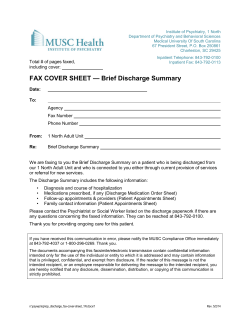
Speaker Handouts - Case Management Society of
u Risk Management in the Transitions of Care For the Case Manager April 21, 2015 Deborah S. Baden, BA, BSN/RN, JD Director – Risk Management About AAMC • • • • • 2 Anne Arundel Medical Center (AAMC), a regional health system headquartered in Annapolis, Md., serves an area of more than one million people. Founded in 1902, AAMC includes a 350 bed not for profit hospital, a medical group, imaging service, substance use treatment center, and other health enterprises. In addition to a 57-acre Annapolis campus, AAMC has outpatient pavilions in Bowie, Kent Island, Pasadena, Odenton and Waugh Chapel. AAMC is nationally recognized for its joint replacement center, emergency heart attack response and cancer care. A leader in women’s services, AAMC ranks second in Maryland for number of births annually and has a Level III neonatal intensive care unit. AAMC is a Magnet designated hospital for nursing care and professional nursing practice. With more than 1,000 medical staff members, 3,900 employees and 750 volunteers, AAMC consistently receives awards for quality, patient satisfaction and innovation. AAMC is patient family centered and is committed to strengthening the partnership between healthcare providers and patients and their families. PatientFamily Advisors partner in many hospital initiatives. • Describe informed consent. • List areas of risk to the patient at discharge from the hospital. • Describe outcomes of patient safety case studies related to care at discharge. 3 TRANSITIONS OF CARE INFORMED CONSENT 4 5 INFORMED CONSENT • Capacity to make informed decisions ~FACTORS TO CONSIDER • Interpreter services • Advanced Directives • MOLST form • Health information confidentiality & privacy 6 BUILDING TRUSTING, PROFESSIONAL PATIENT – CLINICIAN RELATIONSHIPS 7 CASE STUDY #1 CONFIDENTIALITY 8 • Young female patient presents to the ED for treatment accompanied by a young man • Nurse recognizes patient from previous visit and asks patient how her baby is doing • The young man left • The hospital received a privacy complaint for disclosing information not pertinent to the care being provided • The patient had given her child up for adoption and not discussed her past history with her fiancé 9 The ANA’s 6 Tips to Avoid Problems with Social Media 1. Remember that standards of professionalism are the same online as in any other circumstances. 2. Do not share or post information or photos gained through the nurse-patient relationship. 3. Maintain professional boundaries in the use of electronic media. Online contact with patients blurs this boundary. 4. Do not make disparaging remarks about patients, employers or co-workers, even if they’re not identified. 5. Do not take photos or videos of patients on personal devices, including cell phones. 6. Promptly report a breach of confidentiality or privacy. Source: The American Nursing Association 10 CASE STUDY #2 SOCIAL MEDIA & CONFIDENTIALITY 11 • University of Arizona Medical Center ED employee posted photo on Facebook with workstation screen in the background • Facebook post was removed within 30 minutes. Patient notified of incident and told to work with credit monitoring services • Department of Economic Security contacted patient 4 months after incident as someone else was using her information to qualify for food stamps • Patient received anonymous calls to her home and cell phone • Patient is afraid to be at home and has retained an attorney TRANSITIONS OF CARE DISCHARGE PLANNING 12 42 CFR 482.13 (b) (1) and (2) INFORMED CONSENT Discharge Planning • Patient has right to make informed decisions regarding his/her care • Patient has the right to participate in the development and implementation of his/her plan of care • Patient or patient’s representative has the right to be actively involved throughout the discharge planning process. • Patient may exercise the right to refuse to participate in discharge planning or to implement discharge plan 13 Joint Commission • PC.04.01.01 – “…a process that addresses the patient’s need for continuing care, treatment, and services after discharge or transfer”. • PC04.01.03 – “...discharge planning process early in the patient’s episode of care, treatment”. • PC.04.01.03 – “… identifies any needs the patient may have for psychosocial or physical care, treatment, and services after discharge or transfer”. • EP 4 – “Prior to discharge, the hospital arranges or assists in arranging the services required by the patient after discharge in order to meet his or her ongoing needs for care and services. 14 CENTERS FOR MEDICARE & MEDICAID SERVICES (CMS) HOSPITAL CONDITIONS OF PARTICIPATION (COP) 42 CFR §482.43: DISCHARGE PLANNING “TRANSITION PLANNING” APPROPRIATE DISCHARGE DESTINATION Screen for risk of adverse health consequences post discharge 15 HEATLHCARE NEEDS Evaluation of post discharge needs QUALITY Progress DISCHARGE towards careplan goals after Initiate implementation discharge of the discharge plan prior to discharge Joint Commission: Transition of Care Portal Factors that may increase the risk of readmission 16 • Diagnose associated with high readmission • Co-morbidities • The need for numerous medications • History of readmissions • Psychosocial and emotional factors related to mental health • Lack of family member, friend or other caregiver who could provide support • Older age • Financial distress • Deficient living environment Patient Care Conferences PATIENT FAMILY ENGAGEMENT – Defining the healthcare team. – Assessment of healthcare literacy. – Medication management – Coordination of care – Discharge planning 17 • Poor transitions between different providers CAUSES PREVENTABLE READMISSIONS • Premature discharge • Discharge to inappropriate setting • Lack of information or resources to ensure continued services • Poor coordination of care • Incomplete communication between inpatient and community based providers • Adverse events following discharge 18 TRANSITIONS OF CARE ADVERSE EVENTS 19 Statistics -2003 • 23% of patients over 65 yrs. old are transferred to skilled nursing facility. 19% of those individuals are readmitted within 30 days • Study at 800 bed urban teaching hospital found 20% of 300 patients interviewed at 3 weeks post discharged had experienced an adverse event. • 1/3 are preventable. 20 Statistics -2004 • Approximately 1 in 5 medical patients experience an adverse event during the first several weeks after hospital discharge. • 1/3 of them are associated with disability • 1/2 are associated with use of additional health services. • 2/3 of them are adverse drug events. 21 Statistics - 2005 • 34% of patients who participated in a patient survey (2005) reported experiencing medical mistakes, medication errors or lab errors. • The number of patients increased by 14% if they had 4 or more physicians providing care. 22 Statistics 2007 • Following discharge nearly half (49%) of hospitalized patients experience 1 medical error in – Medication continuity – Diagnostic workup – Test follow up. • 19-23% of patients suffer adverse events: 23 DISCHARGE SUMMARIES • At time of patients first follow up with their PCP after hospitalization, discharge summaries have not yet arrived about 75% of the time. • Restricting PCP ability to provide follow up care in 24% of hospital follow-up visits. 24 • COORDINATION OF CARE BETWEEN FACILITIES • DISCHARGE INSTRUCTIONS • MEDICATION RECONCILIATION • HEALTHCARE TEAM COMMUNICATION • PERFORMING FINAL PHYSICAL ASSESSMENT 25 • A woman with jaundice and liver failure was discharged with instructions to go to a facility 82 miles away by private automobile. The patient’s car broke down en route. • The patient, who was being driven to the second facility by her son, said she had been “released from hospital.. due to no insurance and was told to follow up at Facility B and given directions to Facility B to go. Via private vehicle despite patient weakness and low blood pressure. • Family states they were driving patient to Facility B when vehicle broke down and ..was unable to continue and called 911. • She arrived jaundiced and in septic shock. The episode resulted in her death that day. • Hospital fined $100k CASE #1 COORDINATION OF CARE interfacility transfer 26 CASE #2 DISCHARGE INSTRUCTIONS • Family member called the nursing unit stating the discharge instructions were unclear • The nurse discovered the medication discharge instructions were not completed. • The patient had received a coronary artery stent and the booklet was still with the chart. • The daughter was also unclear of the pacemaker instructions • The daughter was unclear on the length of time the antibiotic was to be continued. 27 • Patient discharged to nursing home. Case #3 DISCHARGE MEDICATION RECONCILIATION • Discharge orders for 50 mcg Fentanyl but was written for 500 mcg. • The nursing home did not catch error until patient became very drowsy. • Narcan was administered. • Patient re-admitted to the hospital with change in level of consciousness- drug induced. • Patient expired several weeks later, not fully recovering from medication error. 28 CASE #4 HEALTHCARE TEAM COMMUNICATIONS • Patient had a brief pause on the cardiac monitor. The monitor strip was placed on the medical record but the physician was not notified. • The patient was discharged the following morning. • The patient’s spouse called to report the patient passed out after leaving the hospital. • As instructed, they returned to the ED, and the patient was admitted. • The patient had a dual chamber pacemaker inserted the next day. 29 Case #5 PENDING TEST RESULT • Patient was admitted with diagnosis of thrombus right arm. • The x-ray of right elbow was ordered. • Patient was discharged to an extended care facility via ambulance before right elbow x-ray done. • Orthopedic doctor notified of x-ray not being done which would have been the basis for cancelling the discharge order. 30 CASE #6 PERFORMING FINAL PHYSICAL ASSESSMENT • Patient was discharged to another facility with the right femoral triple lumen catheter still in place. • The nurse discovered the femoral line and called the other facility. • The staff asked how long and how much pressure to hold on the femoral site when removing the catheter. 31 • Assess – Patient’s health literacy. – Screen patients for discharge on admission; – Advocate for multidisciplinary teams to evaluate and implement discharge needs. • Finalize the plan with the patient. – Communicate with an interpreter, if needed. – Request a verbalized understanding of education and plan – Document the encounter. 32 • Perform final physical assessment – Attention to removal of items not intended to continue after discharge • Provide complete and accurate written discharge instructions; – Medication administration instructions- drug actions & side effects; – Follow up appointments; – Diet; – Signs and symptoms that may develop; – When to call the MD – When to seek emergency medical care • Provide telephone follow up 2 to 3 days after discharge. 33 • Reveal information in the company of patient’s social support after patient gives permission. • Report adverse events found upon readmission through your organization’s reporting channels of patient safety incidents. • Know organization’s policies – – – – 34 Patient privacy Informed consent. Hospital discharge planning Adverse event reporting 35
© Copyright 2025









